Blog

Prepayment Rates May Foretell Stronger Refi Originations
Prepayment rates, an indicator ofrnrefinancing activity, increased slightly in April, the second consecutive monthlyrnincrease, as interest rates declined Black Knight Financial Services saidrntoday. Those rates, which had neared 2rnpercent of outstanding mortgages in late 2012 and early 2013 as interest rates achievedrnrecord lows of less than 3.5 percent, fell through mid-to-late 2013 as ratesrnrose more than a point. With the recentrnpull-back in interest rates prepayments have risen, reaching .87 percent inrnApril. </p
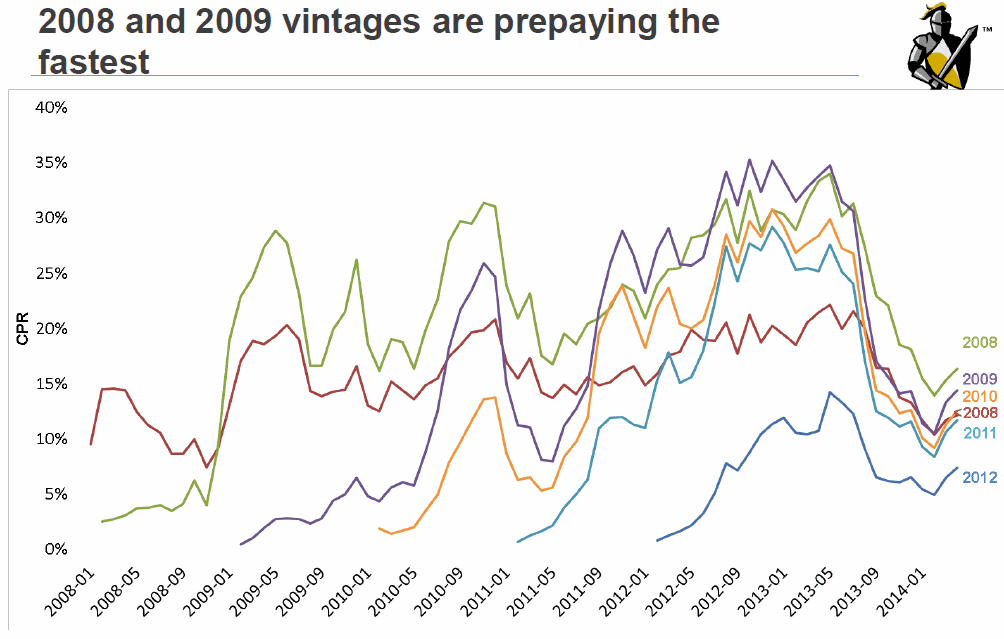 </p
</p
Black Knight’s Mortgage Monitor reports that the bump in prepayment activity heldrnacross all post-recession vintages of loans, but loans originated in 2008 andrn2009 were prepaying the fastest in April. rnThe uptick also occurred for loans despite their combined loan-to-valuernratios (CLTV) but those with CLTVs under 100 percent increased by over one thirdrnbetween February and April while refinancing for loans with the highest CLTV’srnwent up by about 20 percent.</p
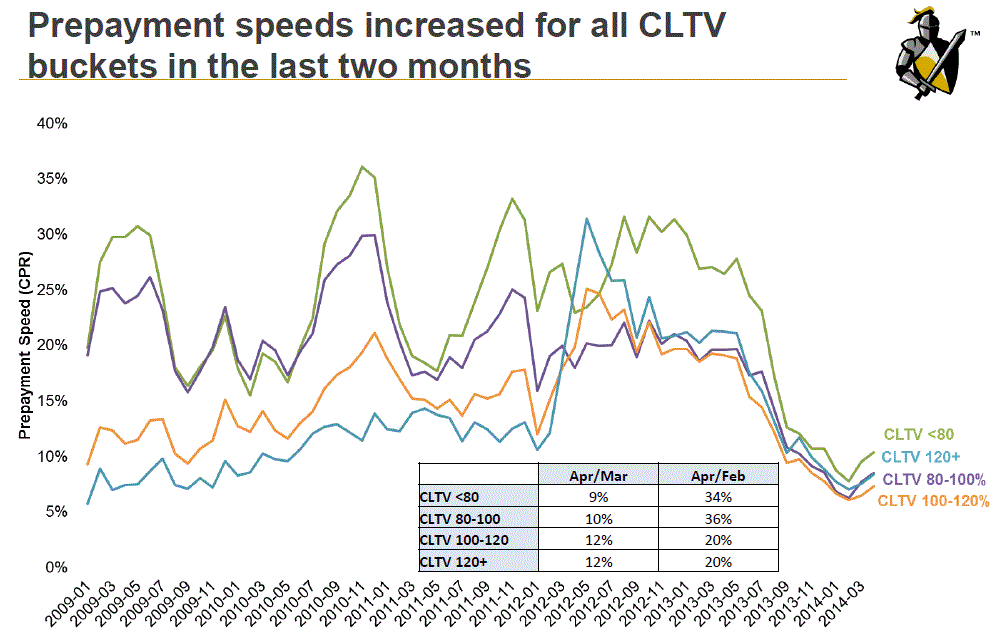 </p
</p
Prepayment rates for adjustable raternmortgages (ARMS) were generally higher than those for fixed-rate mortgagesrn(FRMs) except in the highest rate bucket (6-6.5 percent). BlackrnKnight said this suggests that concerns about rising interest rates persistrnamong the borrower population, despite the recent pullback in 30-yearrnconforming rates. Prepayments for ARMsrnwere highest among those with interest rates under 6 percent with loans in thern5-5.5 percent bucket prepaying the fastest.</p
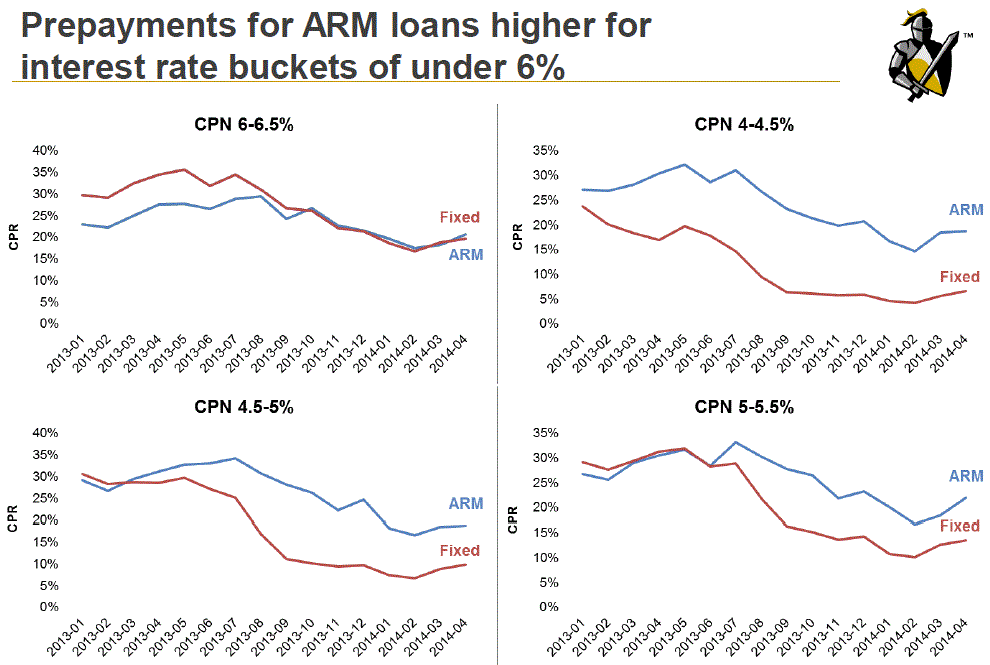 </p
</p
Significant numbers of households holdrnmortgages that are refinancible and the numbers that are priced out becauserntheir current interest rate makes refinancing unfeasible has stabilized sincernthe first of the year along with rates. rnBlack Knight estimates that there are about 5.1 million refinanciblernmortgages in the U.S.</p
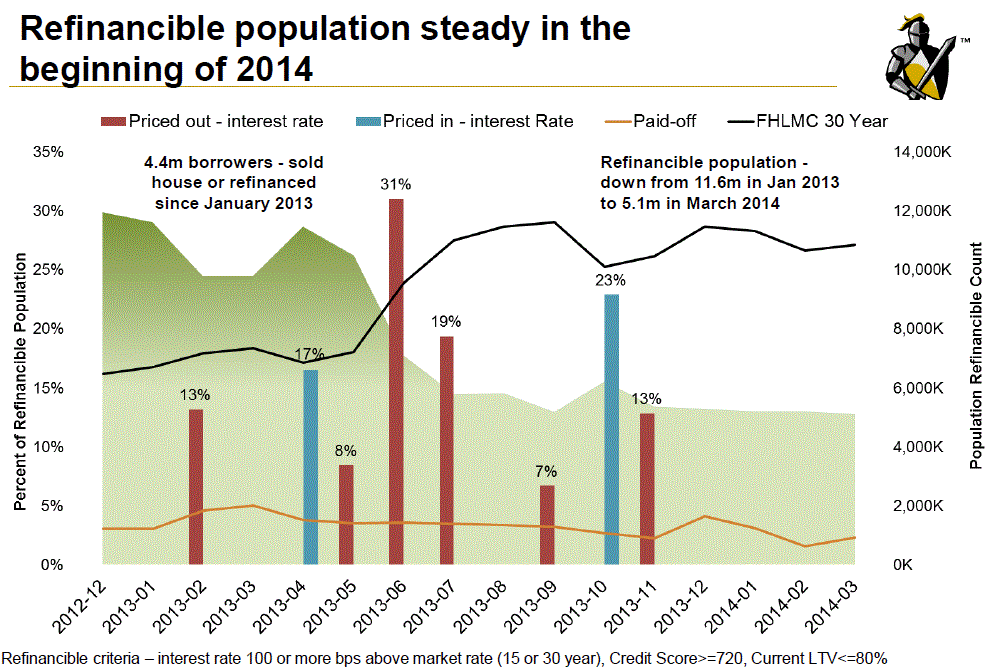 </p
</p
Mortgage originations increased 18rnpercent in March with refinancing rising 13 percent from the previous monthrnwhile purchase originations were up 21 percent. rnPurchase mortgages represented 67 percent of originations in the firstrnquarter of the year compared to 27 percent in the first quarter of 2013.</p
Loans that have refinanced in recentrnyears through the Home Affordable Refinance Program (HARP) which was designedrnto assist borrowers otherwise unable to refinance because of high LTVs arernreported by Black Knight to be performing better than loans originated duringrnthe same period to purchase homes. Thern60 day delinquency rate for HARP loans with LTVs greater than 100 percent had arnhigher delinquency rate in each time period than those with LTVs below thatrnfigure and both had higher delinquency rates than conventional refinancing but bothrntypes of HARP loans had delinquency rates well below loans originated for homernpurchase until 2013. While those loansrnhave only a brief history, the higher LTV HARP loans are running a 60 dayrndelinquency rate that is double that of purchase loans. </p
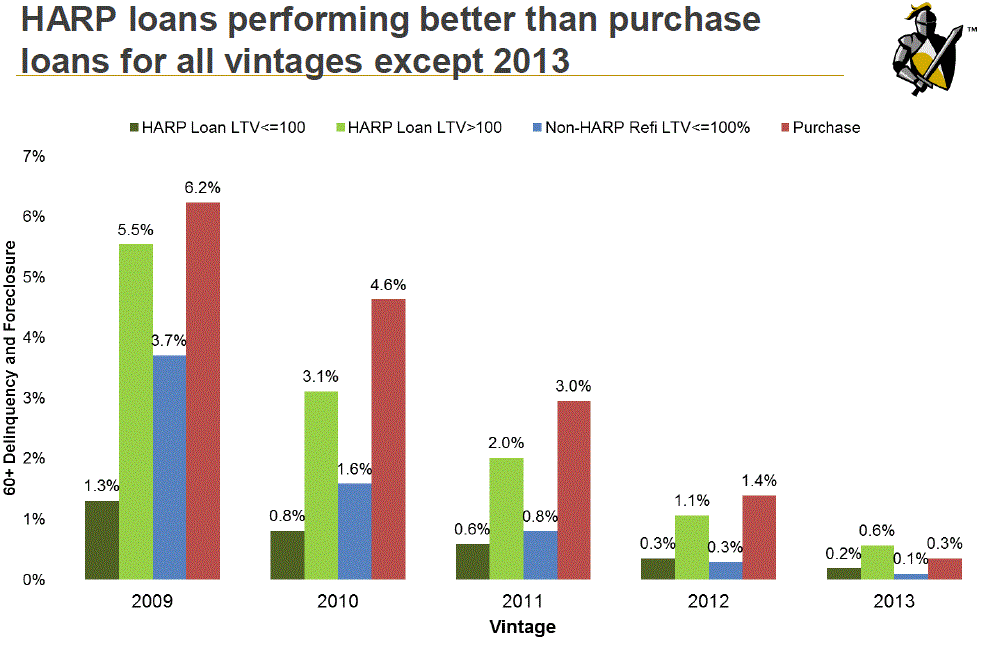 </p
</p
Black Knight notes that negative equityrnis a major driver of loan defaults with delinquency rates rising in locksteprnwith the degree the property is underwater. rn The percentage of underwaterrnhomes has steadily decreased as home prices have risen but Black Knight pointsrnout, negative equity now presents a new concern. As of April, there were approximately 2rnmillion modified mortgages facing interest rate resets and more than 40 percentrnof those loan modifications are currently underwater.</p
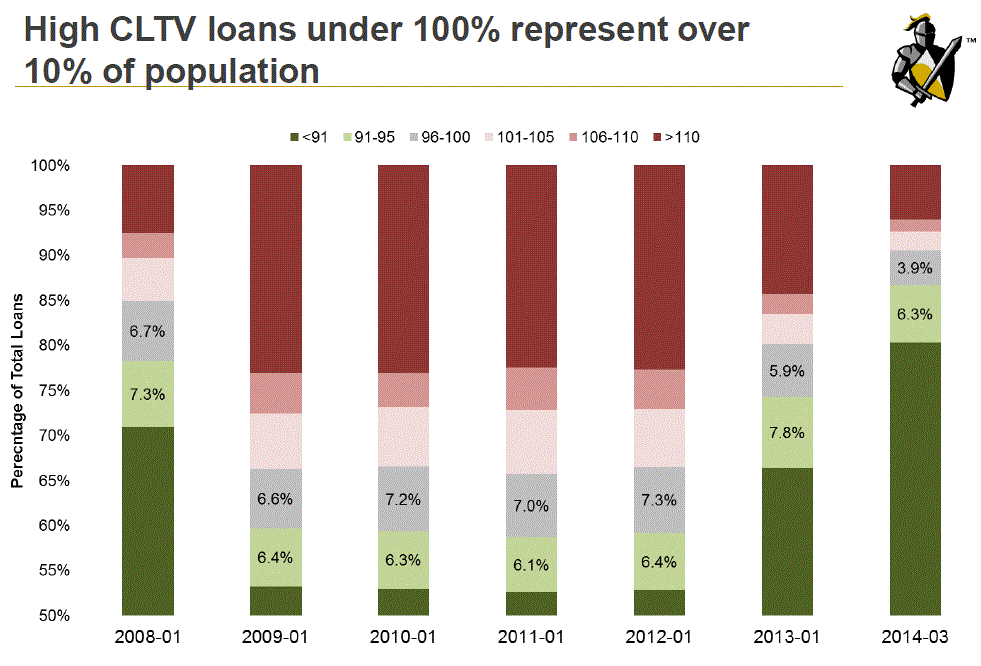 </p<p<br /"We have seen a continual reduction in the number of underwater borrowersrnat the national level for some time now, but modified loans show a differentrnpicture," said Kostya Gradushy, Black Knight's manager of Loan Data andrnCustomer Analytics. "While the national negative equity rate as of Aprilrnstands at 9.4 percent of active mortgages, the share of underwater modifiedrnloans facing interest rate resets is much higher — over 40 percent. Inrnaddition, another 18 percent of modified borrowers have 9 percent equity orrnless in their homes. Given that the data has shown quite clearly that equity –rnor the lack thereof — is one of the primary drivers of mortgage defaults,rnthese resets may indeed pose an increased risk in the years ahead.</p
</p<p<br /"We have seen a continual reduction in the number of underwater borrowersrnat the national level for some time now, but modified loans show a differentrnpicture," said Kostya Gradushy, Black Knight's manager of Loan Data andrnCustomer Analytics. "While the national negative equity rate as of Aprilrnstands at 9.4 percent of active mortgages, the share of underwater modifiedrnloans facing interest rate resets is much higher — over 40 percent. Inrnaddition, another 18 percent of modified borrowers have 9 percent equity orrnless in their homes. Given that the data has shown quite clearly that equity –rnor the lack thereof — is one of the primary drivers of mortgage defaults,rnthese resets may indeed pose an increased risk in the years ahead.</p
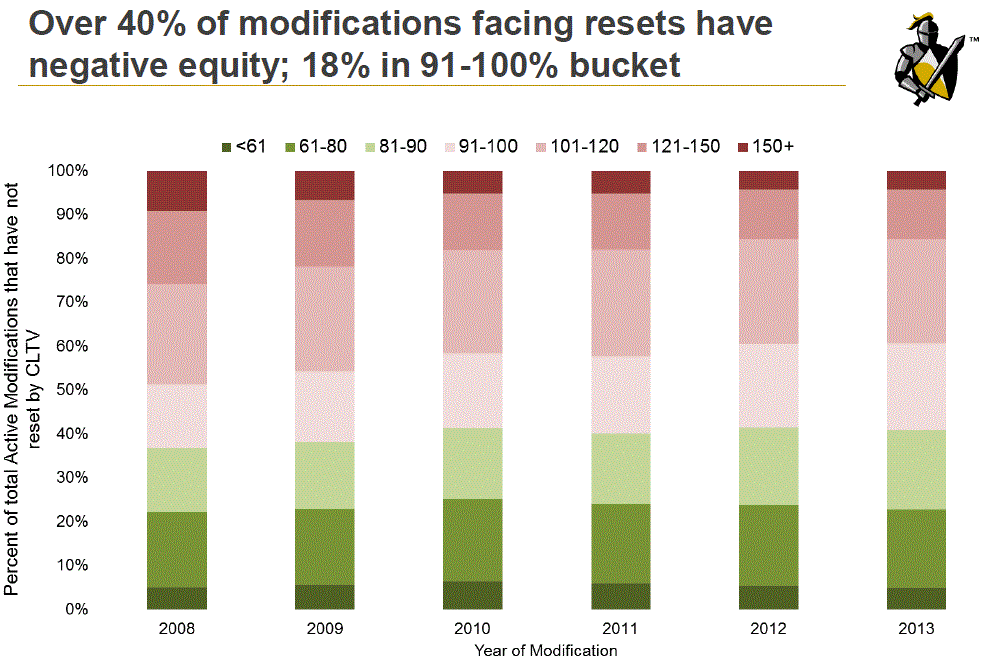 </p<p<br /"From a broader perspective, it's also important to note that more thanrnone of every 10 borrowers is in a 'near negative equity' position, meaning thernborrower has less than 10 percent equity in his or her home. This isrnparticularly pronounced in New Mexico and Southern states. At a local level –rnand we look at both mortgage performance and Home Price Index (HPI) data downrnto ZIP code granularity — such slim margins in equity can have a significantrneffect on overall negative equity levels with even slight variations in HPI.rnSo, while the overall situation for underwater borrowers has improvedrnsignificantly, there are still areas in the country where borrowers arernhovering at the edges.”</p
</p<p<br /"From a broader perspective, it's also important to note that more thanrnone of every 10 borrowers is in a 'near negative equity' position, meaning thernborrower has less than 10 percent equity in his or her home. This isrnparticularly pronounced in New Mexico and Southern states. At a local level –rnand we look at both mortgage performance and Home Price Index (HPI) data downrnto ZIP code granularity — such slim margins in equity can have a significantrneffect on overall negative equity levels with even slight variations in HPI.rnSo, while the overall situation for underwater borrowers has improvedrnsignificantly, there are still areas in the country where borrowers arernhovering at the edges.”</p
Finally, as foreclosure sales (completions)rnincreased in both judicial and non-judicial states — though the increase wasrnlarger in the former than the latter — Black Knight observed the gap betweenrnjudicial and non-judicial pipeline ratios (ratio of loans 90 or more days pastrndue or in foreclosure to the current rate of foreclosure completions) hadrnnarrowed to its lowest point since at least 2005. The judicial states’ pipelinernratio now stands at 52, as compared to its high of 118 months back in 2011. Inrncontrast, the non-judicial states’ pipeline ratio at that time was 33 months –rnit has now increased to 48, its highest point on record.</p
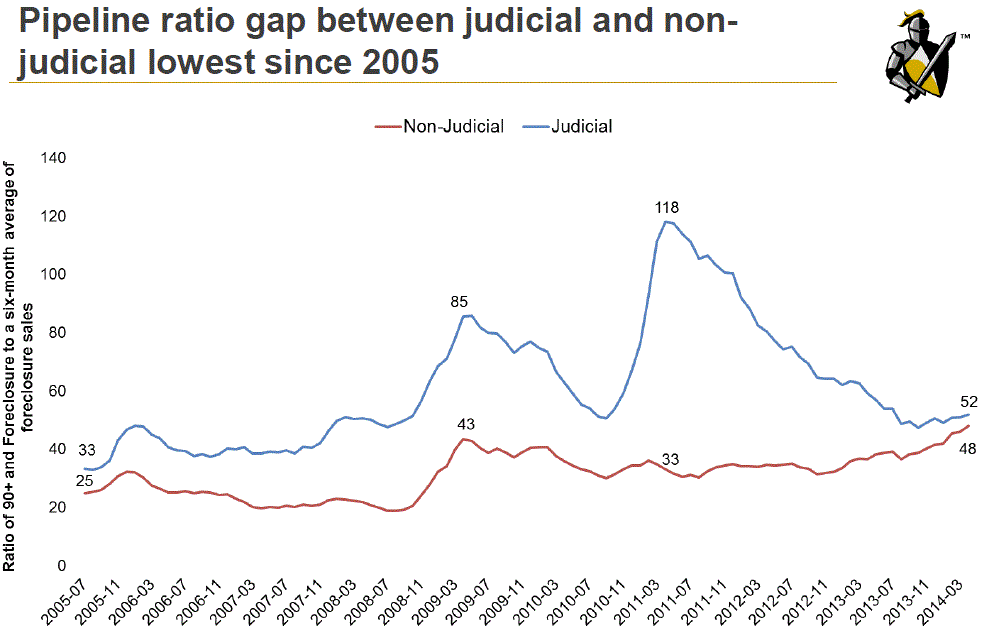
All Content Copyright © 2003 – 2009 Brown House Media, Inc. All Rights Reserved.nReproduction in any form without permission of MortgageNewsDaily.com is prohibited.
Latest Articles
By John Gittelsohn August 24, 2020, 4:00 AM PDT Some of the largest real estate investors are walking away from Read More...
Late-Stage Delinquencies are SurgingAug 21 2020, 11:59AM Like the report from Black Knight earlier today, the second quarter National Delinquency Survey from the Read More...
Published by the Federal Reserve Bank of San FranciscoIt was recently published by the Federal Reserve Bank of San Francisco, which is about as official as you can Read More...

Comments
Leave a Comment